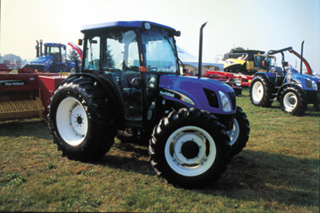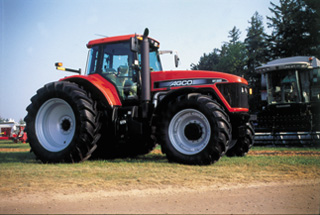
Features
Desiccants
Seed & Chemical
Integrated Canada thistle control on pastures
Get the best results with fertilizer, herbicides and rotational grazing.
November 27, 2007 By Bruce Barker
Canada thistle is a noxious and very difficult to control perennial weed. But
a major research project spearheaded by Edward Bork, a range management specialist
at the University of Alberta, has developed integrated management recommendations
for controlling Canada thistle on pasture. The research was a combined effort
between Alberta Agricultural Research Institute (AARI), the University of Alberta,
Alberta Agriculture, Food and Rural Development, over a dozen municipal counties,
BASF Canada and Dow AgroSciences.
 |
| Canada thistle can take over pasture. Photos Courtesy Of Edward Bork, University of Alberta. |
Bork says that the research helps producers assess their Canada thistle problems
and design the best control systems that maximize forage production. "An
integrated approach provides the best way to control Canada thistle. Additionally,
we found that taking inappropriate management actions may actually increase
Canada thistle populations and decrease forage production," he explains.
Estimating yield loss on pasture
One of the first objectives of the study was to determine the forage yield loss
due to Canada thistle infestations. This information represents the first critical
step in making sure producers are aware of the opportunity cost associated with
having weedy pastures. Assessments were conducted at eight sites in the Aspen
Parkland of central Alberta to correlate Canada thistle density or biomass to
yield loss. All sites were typical tame pastures dominated by common grasses
including smooth brome, Kentucky bluegrass and quackgrass.
The research showed that forage yield typically declined with increasing Canada
thistle abundance. Observed relationships were inconsistent among sites, likely
the result of variation in soils, forage species and local growing conditions.
However, the overall trend showed that increasing Canada thistle abundance resulted
in a decrease in forage yield, with losses approaching 2kg/ha of forage for
each 1kg/ha of the weed.
Herbicides work best in conjunction with fertilizer
The study also examined whether a one-time herbicide application or mowing could
provide effective Canada thistle control on pastures, and whether an annual
spring application of fertilizer (N-P-K-S) would influence the long-term effectiveness
of weed control for up to three years. Four herbicides were compared to mowing
and a check treatment at four sites across central Alberta. A fertilizer blend
of 100-45-10-15kg/ha of N-P-K-S was also applied in the spring according to
soil test recommendations, in each year of the study. The four herbicides included
2,4-D ester 700 (2.5L/ha), Lontrel (0.6L/ha), Grazon P+D (3.7L/ha) and Dyvel
DS (3.25L/ha).
Notably, fertilizer addition in the absence of any control measures increased
forage yields and quality, but also increased Canada thistle abundance by about
25 percent. Similarly, a one-time mowing treatment actually increased Canada
thistle shoot densities in the year of treatment. "These results indicate
producers who use mowing as an emergency treatment, such as in response to weed
notices, may be making the Canada thistle problem worse," says Bork. "Fertilization
of weedy pastures in the absence of weed control represents an obvious waste
of resources and money. As a result, pasture fertilization and infrequent mowing,
alone or in combination, are not recommended for Canada thistle control."
Bork reports that a one-time application of herbicides resulted in effective
suppression of Canada thistle in the year of treatment, regardless of whether
herbicides were combined with fertilization. However, subsequent annual spring
fertilization was important for enhancing the longer-term, residual control
of Canada thistle by herbicides. While Canada thistle showed considerable signs
of recovery in unfertilized plots during the second and third years of study,
fertilized plots gave rise to healthier, more vigorous grass stands that provided
increased competition with, and suppression of, Canada thistle.
"This is likely a result of the increased vigour of the forage stand associated
with fertilization, which in turn, suppressed recovery of damaged thistle,"
explains Bork.
Grazon P+D and Lontrel, applied at the early bud stage of Canada thistle in
July, combined with spring fertilization, provided the greatest Canada thistle
suppression at the end of the third growing season. Dyvel DS and 2,4-D also
suppressed Canada thistle over this period.
All herbicides reduced forbs, including desirable legumes. Bork says that specific
recommendations for Canada thistle control will ultimately vary depending on
forage composition and management objectives. If maintaining species diversity
is important, such as in the case of native rangeland communities, the use of
herbicides may not be the best control strategy as most herbicides reduced species
richness, diversity and native species cover.
| Figure 1. Canada thistle density data in the fertilizer x control treatments in 2001 (year 3). Source: Management of Canada Thistle in Pasture; AARI 2005. |
 |
| Figure 2. Canada thistle control with weed wiping at three pasture sites in central Alberta. Year of treatment 2000. Source: Management of Canada Thistle in Pasture; AARI 2005. |
 |
| Figure 3. Forage yields after fertilizer and herbicide treatment (1999). Rating one year after Canada thistle treatment in 2000. Source: Management of Canada Thistle in Pasture; AARI 2005. |
 |
Additionally, Canada thistle-infested pastures dominated by grasses but containing
a large proportion of desirable legumes, may be more difficult to manage if
the maintenance of legumes is a priority. Bork has recently initiated a new
four year study in conjunction with Dow AgroSciences and the National Sciences
and Engineering Research Council of Canada to examine strategies to effectively
manage pastures containing both legumes and weeds.
Where legumes were not abundant, annual spring fertilization combined with
Lontrel or Grazon P+D applied at the early bud stage appeared to provide the
greatest reduction in Canada thistle within permanent pasture, while simultaneously
increasing grass production and crude protein yield.
Based on field experiments, weed wipers also appear to be a suitable alternative
to broadcast spraying for perennial weed control in permanent pastures. Weed
wipers directly apply concentrated herbicide to tall-stature weeds within the
forage stand using saturated sponges. Bork explains that the advantages of wiping
compared to spraying include environmental benefits such as decreased herbicide
drift and damage to non-target species, economic benefits such as reduced damage
to legumes, and lower cost as the amount of herbicide used is proportional to
the amount of weeds treated. He compared weed wiping using glyphosate, Dyvel
DS, Lontrel and Grazon P+D at cost equivalent concentrations based on retail
herbicide prices, although only glyphosate is currently registered for weed
wiping control of Canada thistle in pasture.
Wiping with glyphosate at 33 percent concentration of the commercial formulation
at either the late bud or fluff stage provided reasonable suppression up to
two years after application. However, adequate height separation between Canada
thistle and the forage stand proved critical. Even when preceded by heavy grazing
to achieve separation, wiping with glyphosate impaired grass growth for up to
one year following treatment, which allowed the invasion of weedy annuals.
"The benefits of Canada thistle suppression and maintenance of legumes
did not out-weigh the economic loss from reduced grass production and the subsequent
increase in annual weeds," says Bork. "Therefore, wiping with glyphosate
for Canada thistle control in pastures is not recommended."
Among the other herbicides examined, Dyvel DS applied at 24 percent concentration
led to moderate Canada thistle control one year following treatment. In contrast,
greater suppression of thistle was achieved for two years following a one-time
weed wiping with either Lontrel (two percent concentration) or Grazon (20 percent
concentration). Although all three treatments reduced legumes one year after
application, weed wiping with Dyvel DS, Grazon P+D and Lontrel had the added
benefit of maintaining grass production and minimizing annual weed invasion.
This suggests that weed wiping has the potential to provide a valuable alternative
to broadcast spraying or wiping with glyphosate for Canada thistle control.
Rotational grazing suppresses Canada thistle
Two other studies were conducted to compare continuous, high intensity/low frequency
(HILF) and short duration grazing (SD; moderate grazing at frequent intervals)
for their ability to influence the abundance of Canada thistle in pasture. In
a three year clipping study, the HILF defoliation treatment maximized forage
yield while minimizing thistle density and biomass. Continuous, intensive defoliation
of the forage stand resulted in the lowest season-long forage yield and greatest
thistle abundance. Bork explains, "This study provides strong support for
the notion that the number and size of weeds like Canada thistle respond to
the vigour of neighbouring plants. Where forages were larger, rapidly growing
and more competitive, thistle shoots were fewer and smaller. Overall, the suppression
of weeds clearly depends on having a highly competitive stand of perennial grasses
which, in turn, can be achieved through HILF defoliation."
| Table 1. Effect of weed wiping Canada thistle control on forage yield and composition in 2001 (year of treatment 2000). |
|||||
| – | Grass biomass (kg/ha) | Annual weed biomass (kg/ha) | Legume cover (percent) | Thistle density (No./sq.m) | Thistle biomass (kg/ha) |
| Check | 2994 | 38 | 13 | 29 | 785 |
| Glyphosate | 1818 | 1797 | 17 | 13 | 294 |
| Dyvel DS | 3144 | 332 | 6 | 12 | 370 |
| Lontrel | 3351 | 1 | 5 | 8 | 130 |
| Grazon P+D | 3409 | 22 | 3 | 8 | 81 |
| Source: Management of Canada Thistle in Pasture: AARI 2005. |
|||||
An associated field study employing small-scale grazing trials at four locations
over three years in central Alberta revealed that the HILF system was most effective
in directly reducing above-ground thistle populations over several years. Cattle
activity during grazing in the HILF system minimized thistle shoot development
and flowering, and resulted in the greatest forage production at the end of
the trial.
"With HILF treatment, most of the Canada thistle remained in the rosette
stage. It was also apparent that each grazing period with the HILF treatment
caused an incremental decline in thistle abundance over time," explains
Bork. "Notably, the adoption of a HILF regime similar to that employed
under rotational, management intensive grazing systems, resulted in maximum
forage production and minimum weed abundance. A rare win-win situation for producers."
Bork also stresses that the use of continuous grazing practices should be avoided,
as they resulted in the lowest forage yield and greatest abundance of Canada
thistle.
Use integrated practices that deliver forage health
The overall results of the AARI research project indicate that livestock producers
should control Canada thistle to increase forage yields, and that they have
several tools to accomplish this. Where thistle is an existing problem, the
use of herbicides in conjunction with fertilizer can be effective in controlling
Canada thistle and increasing forage yield. Similarly, changing from a continuous
to a rotational grazing system can reduce thistle and increase forage yield.
While Canada thistle was never totally eliminated, the use of integrated approaches,
including herbicides, fertilizer and rotational grazing, can work together to
minimize the impact of Canada thistle on forage production in the Aspen Parkland
region.